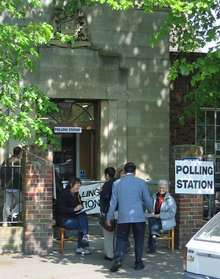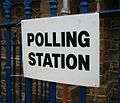Polling place
A polling place[1] is where voters cast their ballots in elections.
The phrase polling station is also used in American English[1] and in British English,[2] although polling place is the building[3] and polling station is the specific room[3] (or part of a room) where voters cast their votes. A polling place can contain one or more polling stations.[3]
Since elections generally take place over a one- or two-day span on a periodic basis, often annual or longer, polling places are usually located in facilities used for other purposes, such as schools, churches, sports halls, local government offices, or even private homes, and may each serve a similar number of people. The area may be known as a ward, precinct, polling district or constituency. The polling place is staffed by officials (who may be called election judges, returning officers or other titles) who monitor the voting procedures and assist voters with the election process. Scrutineers (or poll-watchers) are independent or partisan observers who attend the poll to ensure the impartiality of the process.
The facility will be open between specified hours depending on the type of election, and political activity by or on behalf of those standing in the ballot is usually prohibited within the venue and immediately surrounding area.
Inside the polling place will be an area (usually a voting booth) where the voter may select the candidate or party of their choice in secret. If a ballot paper is used this will be placed into a ballot box in front of witnesses who cannot see for whom the vote has been cast. Voting machines may be employed instead.
Some polling places are temporary structures. A portable cabin may be specially sited for an election and removed afterwards.
There are five different types of voting technologies that are currently being used in the United States polling locations. These include hand counted paper ballots, mechanical lever machines, punch cards, optically scanned paper ballots, and electronic voting machines.[4] Each location is charged with learning the technology and implementing the process to vote in each election.[4]
History
The word "poll" means "scalp" or "head". When votes were taken by gathering people together and counting heads, the place where this was done (sometims an open field) was called the "polls".[5][6]
Polling places used to gather and count ballots in elections have changed significantly over the past 250 years.[7] Advances in technology have played a major role in changing the polling places because as the type of ballot changed, the venue in which the ballots are counted also changed.[7] One of the main reasons for advancement was to be able to access the results quicker. First was the word ballot, then came the different types of paper ballots, and today we have the electronic balloting systems.
Before there were paper ballots, people would simply call out their selection at the polling place. This polling place was typically the county courthouse or town hall.[7] Sometimes these polls were taken outside of the venue in a more informal fashion. When the voters came to the town hall to announce their choice, he or she would get in line to see the judge and swear in.[7] Once the voter put his or her hand on the Bible and swore to the judge, they would be allowed to cast one ballot per election.[7] The judge acted as the only form of voter identification and it was up to them to be able to identify individuals that had already voted and exclude them from voting again.[7]
The use of paper and electronic ballots have been the most widely used form of capturing votes in recent history.[7] When paper or electronic ballots are used, the polling place must be professionally organized in order to ensure that the ballots are not tampered with and are accounted for accurately.[7] These polls are held inside a building that has been set up in stations to assist voters. When the voter arrives he or she will be asked to show a form of voter identification.[7] Once the voter has been properly identified he or she is escorted to a voting booth where the votes are captured.[7] Once all the votes are captured the voter then verifies his or her voting ticket and then submits the ballot either to the poll worker or on the computerized ballot.[7]
Polling location impacts
The building where the polling location is sited can have a significant effect on the results of the poll.[8] Research shows that polling location may have an impact on how a voter casts his or her ballot.[9] This subtle unknown factor can be significant and can sway a close election.[9] Individuals may be influenced to behave in a certain way based on environmental cues,[9] i.e. an object or place that can influence how he or she behaves,[9] for example the condition of the building, the name of the building, the ordinary use of the building, or the building decor.[9] Researchers have spent much time considering what makes people vote the way they do; they have found that the smallest of changes can have large impacts.
Waiting times at polling places have also been a problem in the USA.[10] This has become such a controversial topic that even President Obama in his State of the Union address on February 12, 2013 mentioned the need to decrease waiting times.[10] He went on to say that it is the duty of Americans to make sure that everyone has not only the right to vote, but the opportunity to vote, without having to wait several hours in line.[10]
Building usage
The building used as the polling place has a significant impact on how an individual votes. For example, voting inside a school building, a citizen might be more likely to vote for those in favor of school systems and education.[9] This is especially true if the school building you are voting in is in need of general improvement and/or renovation.[9] This environmental cue may give a voter firsthand knowledge of what needs there may be in a particular setting.[9] In addition, voting inside a church, a citizen might be less likely to vote in favor of stem cell research.[9] These cues give a person a sense of satisfaction for voting one way or another in the moment, regardless if that was the way they intended to vote in the first place.[9]
Distance to voting location
The cost of voting influences whether or not a person will vote. Research shows that the more expensive voting gets, the less likely a person is to vote.[11] Distance to the polling location is one of the main reasons cost can become an issue for voters.[11] Minor changes in distance from voters' homes to polling place can change the turnout of voters, which may change the outcome of a close election.[12] Distance to the polling place is an issue if not every voter has access to vehicle transportation.[11] According to the research on distance to the polling location by Haspel and Knotts, "To illustrate the range of the effect of distance, we plot our predicted probabilities at the lower and upper bounds of our continuous vehicle available variable. When no one owns a car (vehicle available = 0), the likelihood of voting drops from .664 at a distance of .01 miles to .418 at the median distance of .69 miles. When automobiles are universally available (vehicle available = 1), voters are much less sensitive to changes in distance: the likelihood of voting drops from .444 to .392 over the same distance range".[11] Voters ultimately value the convenience of polling locations. If a poll is accessible to the citizen they will make an effort, if the citizen has to travel a long distance then voter turnout decreases dramatically".[11]
Redistricting
If a voter changes precincts due to redistricting then the chances of them continuing to vote in future elections decreases.[11] The confusion that redistricting causes will deter the voter from looking into the new precinct that he or she should now vote in.[11] In addition, the informational costs associated with alerting voters of their new polling location will also affect the voter turnout because it is highly unlikely that funds will be available to allocate to ensure that every voter knows where to vote.[11] Redistricting can be beneficial in order to provide a convenient location but careful consideration should be taken before such a decision is made.
Openness and centralization
If voters are allowed to vote at any of a number of different locations in the county or district etc., this will increase voter turnout.[4] Sometimes a voter's most convenient voting location is near his or her workplace, not necessarily the closest to their residence.[4] Having a more open policy of allowing multiple possible locations for a person to vote would encourage those individuals who cannot feasibly commute back and forth from work to vote.[4] Having a large conspicuous polling location will ensure that the voters know where they are supposed to vote.[4] This will cut down on unnecessary signage and eliminate clutter and confusion.[4]
-
A polling station at a school for the United Kingdom general election, 2010
-

A polling station situated inside a suburban library in the north of Cambridge during the United Kingdom general election, 2005
-

A polling station sign in the Jersey general election, 2008
-
A polling place in New Jersey during the United States presidential election, 2008
-

A polling station in Ban Khung Taphao, Khung Taphao subdistrict, Mueang Uttaradit district, Uttaradit province, Thailand for the Thai general election, 2007.
-
Polling place in a multi functional facility in Silvolde, a village in the East of the Netherlands
-

Interior of a polling station in Wrocław during the Polish presidential election, 2005
References
- 1 2 Oxford Dictionaries http://www.oxforddictionaries.com/definition/american_english/polling-place. Retrieved 29 October 2014. Missing or empty
|title=(help) - ↑ Oxford Dictionaries http://www.oxforddictionaries.com/definition/american_english/polling-place. Retrieved 29 October 2014. Missing or empty
|title=(help) - 1 2 3 Handbook for polling station staff, Accessed 14 September 2014
- 1 2 3 4 5 6 7 Stein, Robert; Vonnahme, Greg (September 2012). "When, Where, and How We Vote: Does it Matter?" 93 (3). Houston, TX: Southwestern Social Science Association: 692–712.
- ↑ http://www.onthemedia.org/story/polling-democracy-uneasy-relationship/
- ↑ http://www.newyorker.com/magazine/2015/11/16/politics-and-the-new-machine
- 1 2 3 4 5 6 7 8 9 10 11 Douglas W. Jones (2003). "A Brief Illustrated History of Voting". Retrieved February 20, 2013.
- ↑ Jack Penland (June 23, 2008). "Voting Influence". Retrieved February 18, 2013.
- 1 2 3 4 5 6 7 8 9 10 Jonah Berger; Marc Meredith (June 1, 2008). "Can Polling Location Influence How Voters Vote?". Retrieved February 18, 2013.
- 1 2 3 Scott Leiendecker (February 14, 2013). "Answer President Obama's call for shorter lines at the Polling Place". Retrieved March 3, 2013.
- 1 2 3 4 5 6 7 8 Haspel, Moshe; Knotts, Gibbs (May 2005). "Location, Location, Location: Precinct Placement and the Costs of Voting" 67 (2). United States of America: Southern Political Science Association: 560–573.
- ↑ Tom Jacobs; Miller-McCune (August 19, 2010). "How Polling Places Can Affect Your Vote". Retrieved February 20, 2013.
External links
| Look up polling place or polling station in Wiktionary, the free dictionary. |
- Handbook for polling station staff, UK Electoral Commission, 2010